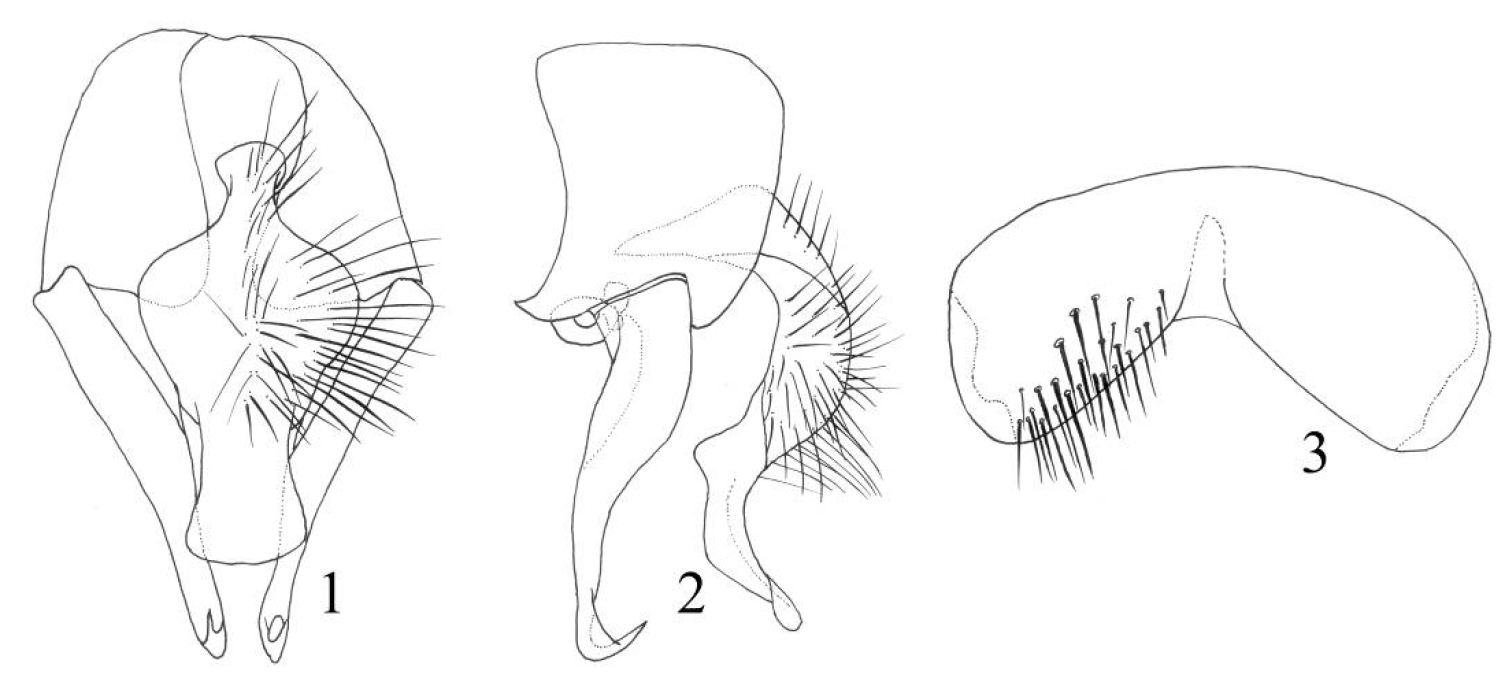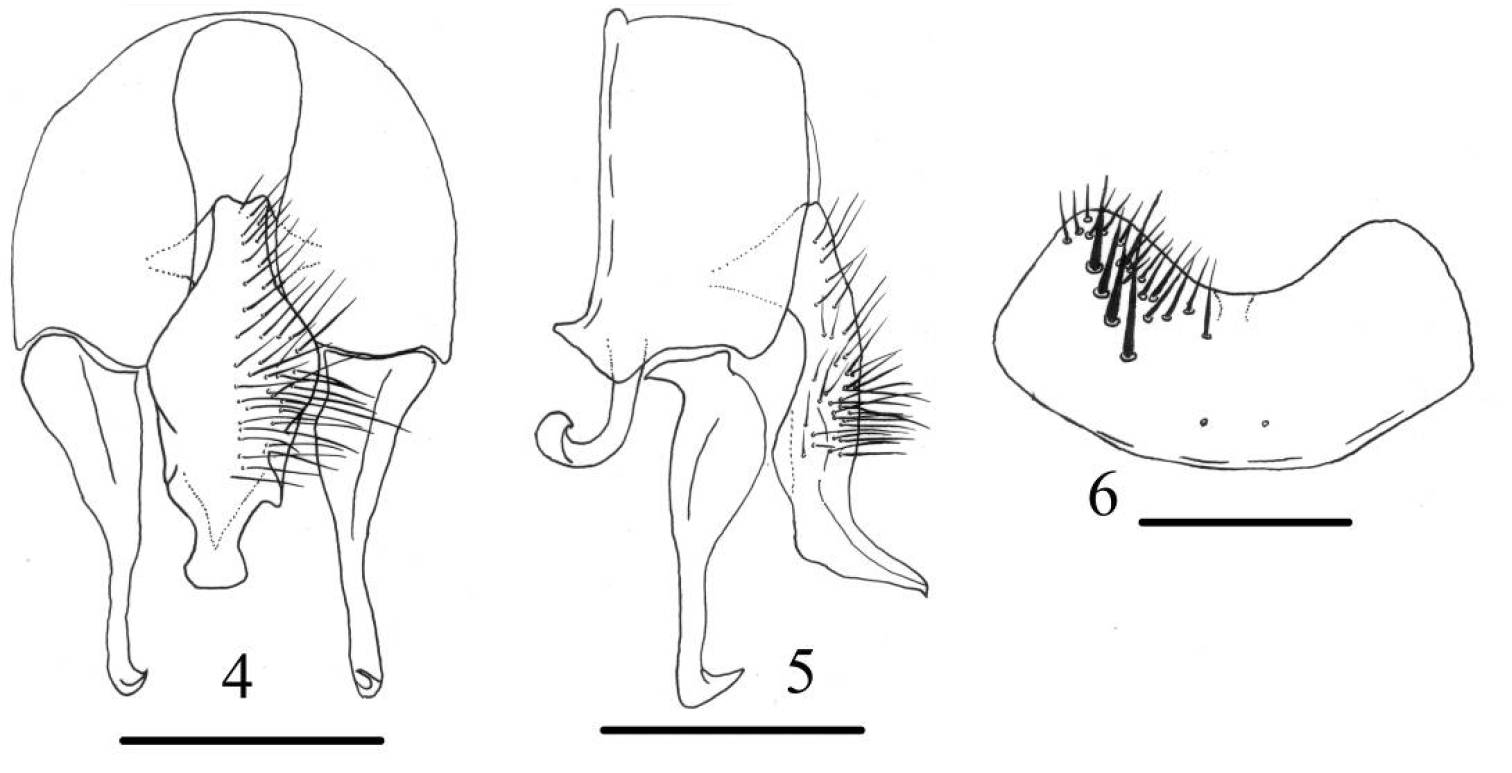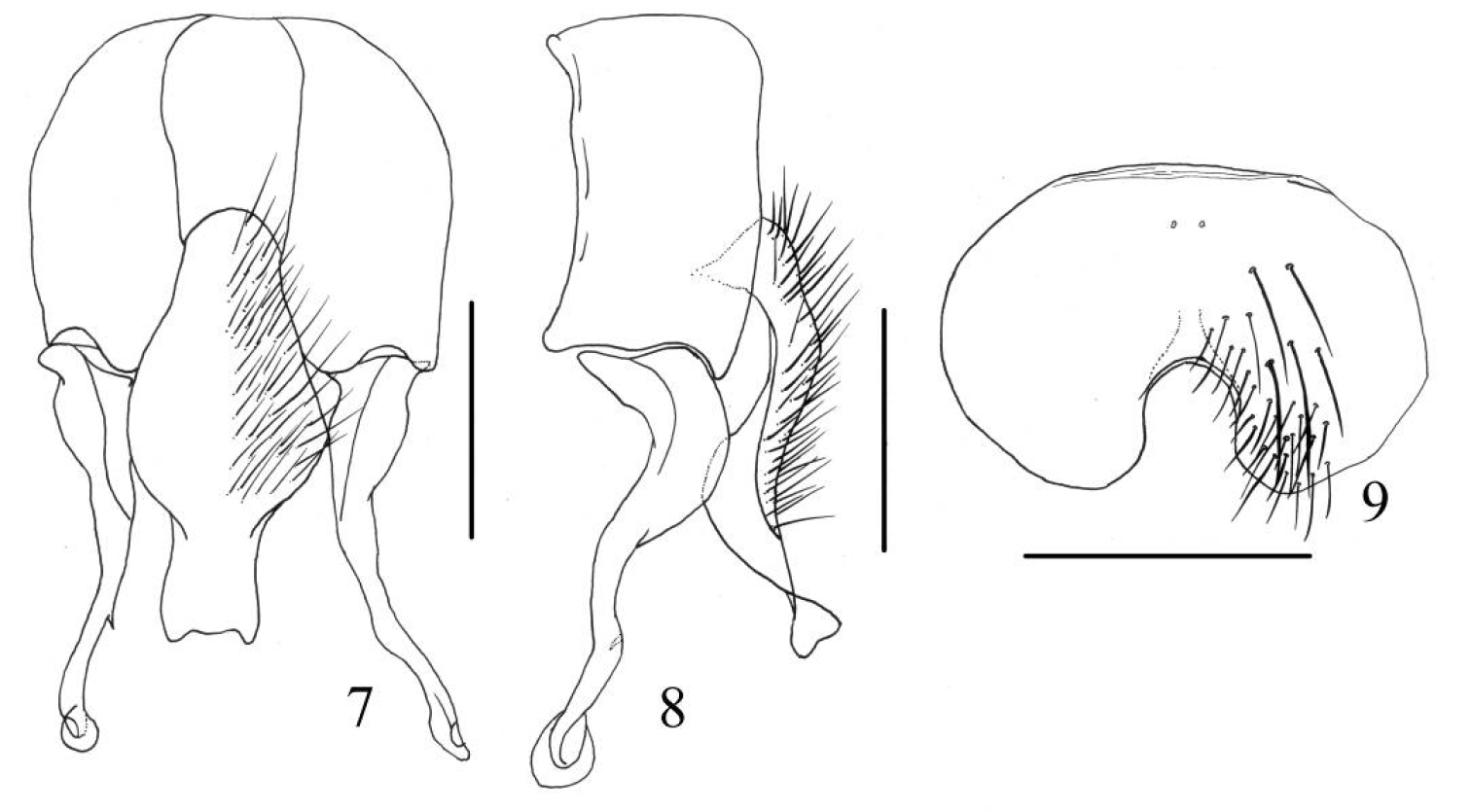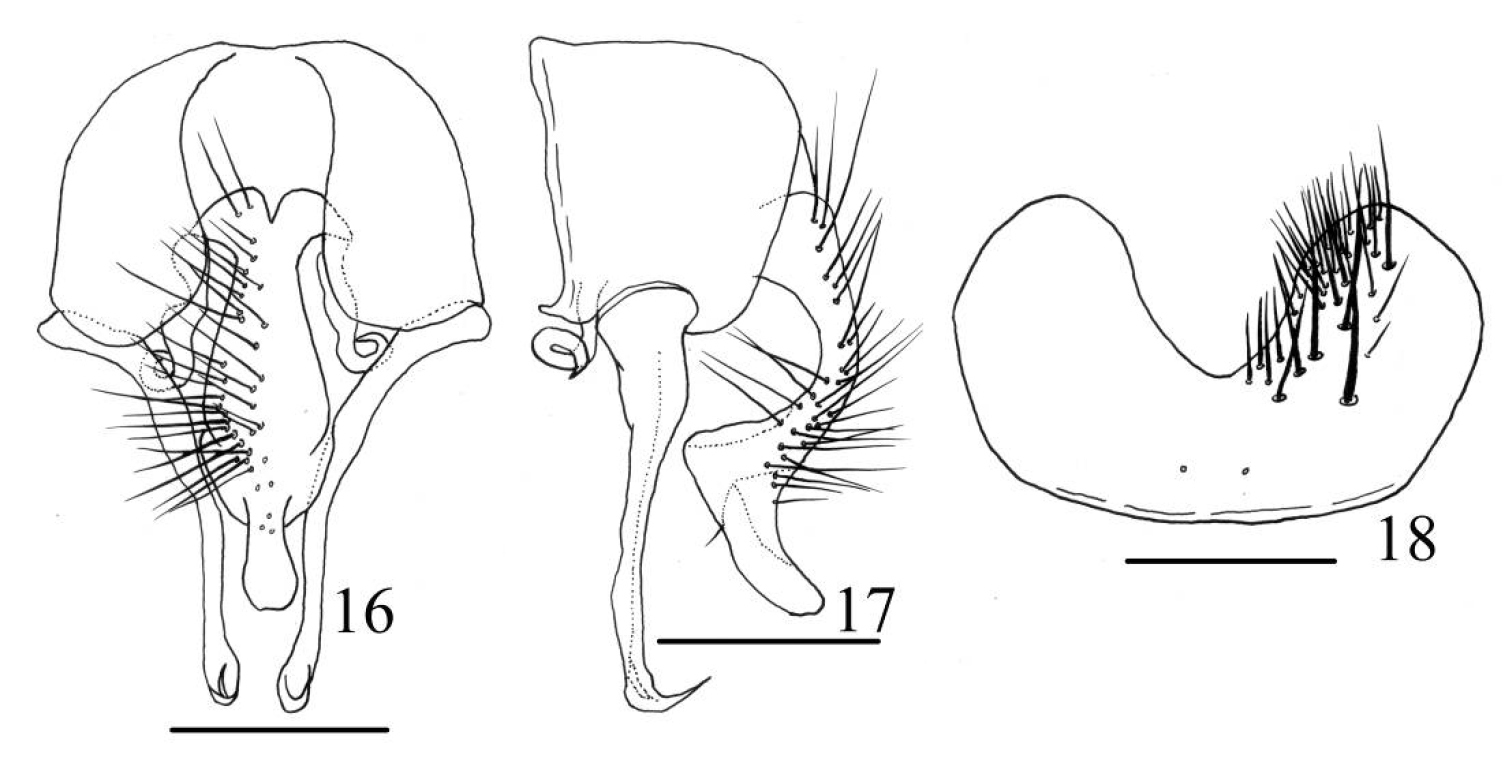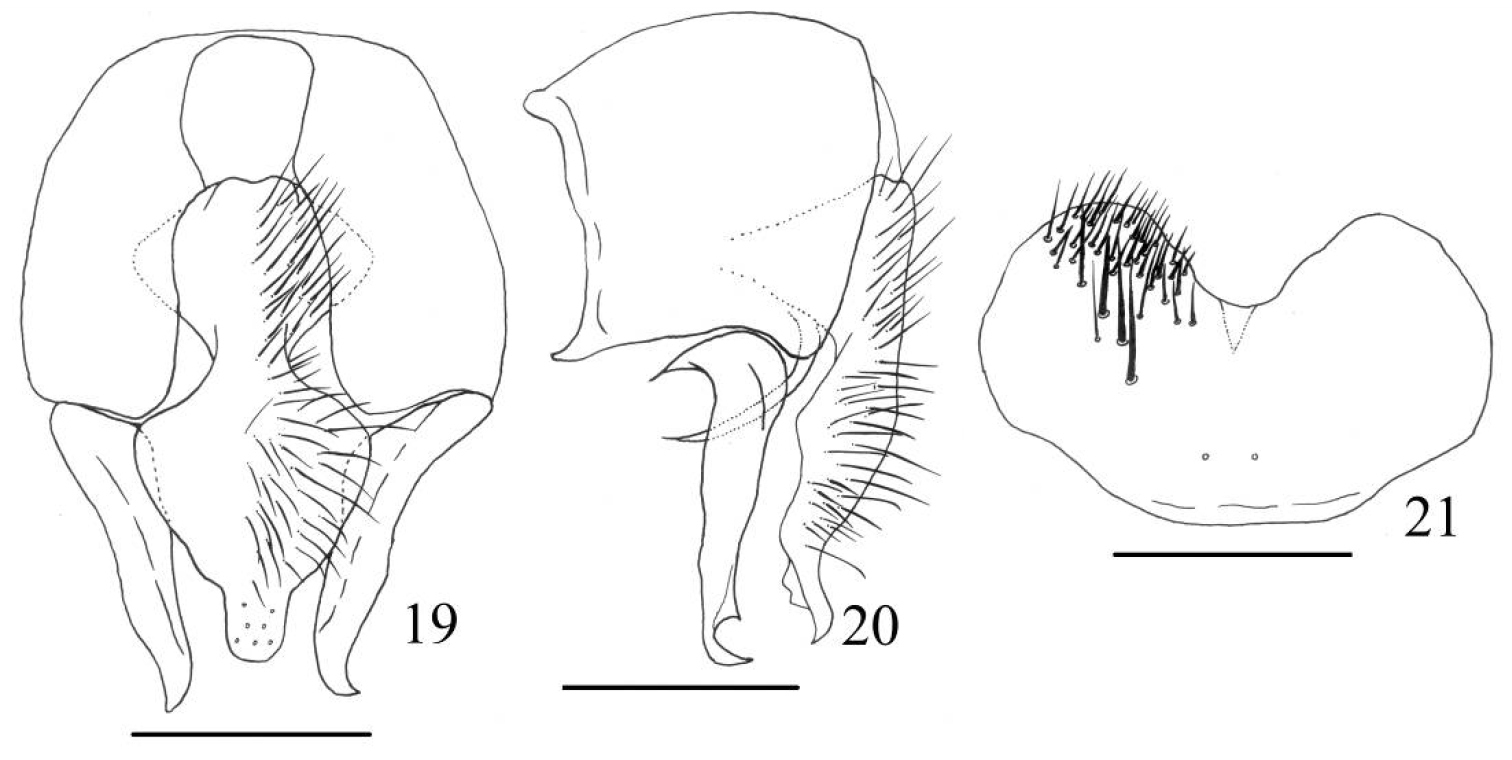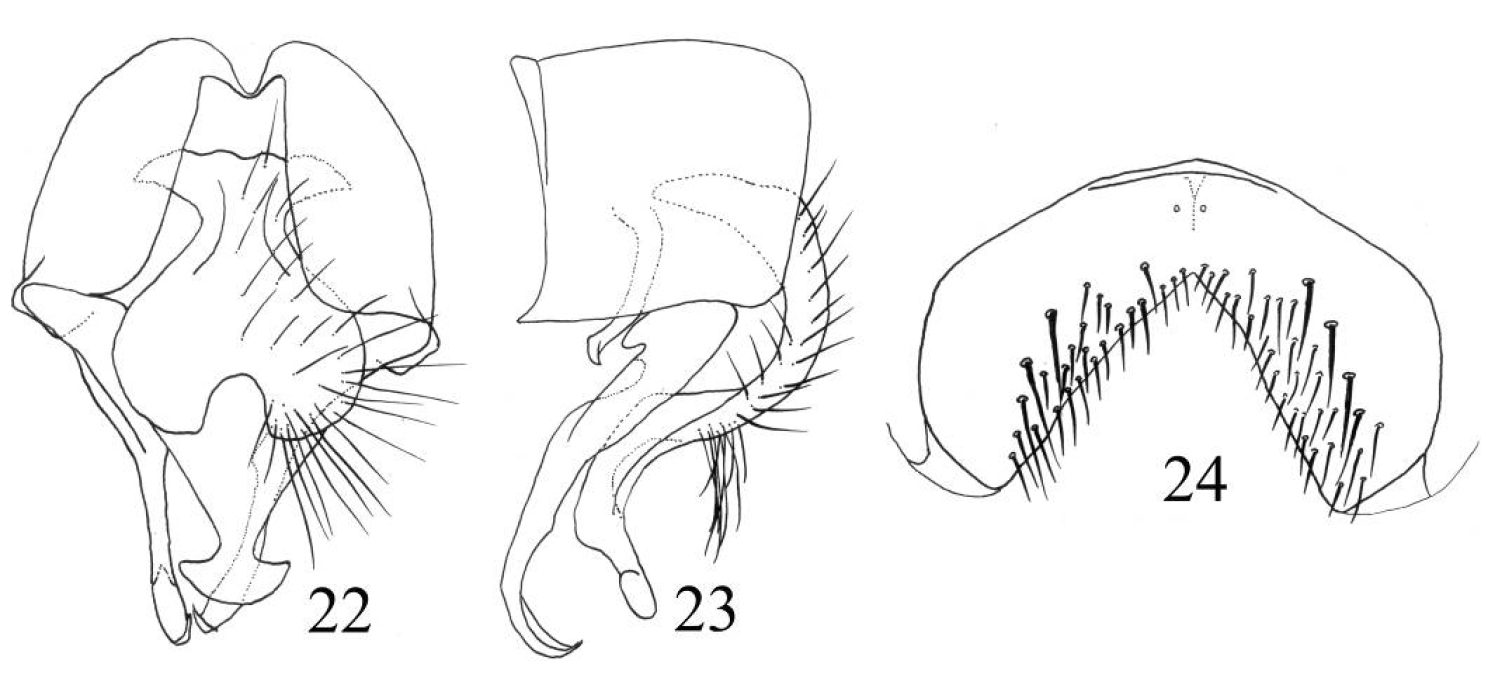(C) 2011 Ming-fu Wang. This is an open access article distributed under the terms of the Creative Commons Attribution License, which permits unrestricted use, distribution, and reproduction in any medium, provided the original author and source are credited.
For reference, use of the paginated PDF or printed version of this article is recommended.
The Chinese fauna of the Fannia postica-group Chillcott (1961) is reviewed, the diagnostic features of this group are redefined, one new species, Fannia nudifemorata sp. n., is described, and a key to the males of nine known species is given. One new junior synonym, Fannia tigripeda Xue, Wang&Li, syn. n. for Fannia stigi Rognes is established. To facilitate comparisons of the species, Fannia aethiops Malloch, Fannia ardua Nishida, Fannia discoculea Xue, Fannia ringdahlana Collin, Fannia postica (Stein), Fannia spathiophora Malloch, and Fannia stigi Rognes are redescribed and illustrated. The geographic distribution of the known Chinese species is updated.
Diptera, Fanniidae, Fannia, Fannia postica-group, new species
The Fannia postica-group was originally established in the genus Fannia Robineau-Desvoidy by
Before the present contribution, eight species of the Fannia postica-group were known in China (
The morphological terminology follows
Our study of the Fannia postica-group was based on an examination of specimens of Fannia postica, Fannia ringdahlana, Fannia aethiops, Fannia ardua, and Fannia spathiophora, and the holotypes of Fannia discoculea, Fannia nudifemorata sp. n., and Fannia stigi. Data on Fannia coculea Nishida was taken from
Each tibia with at most one seta on each surface;
mid first tarsomere usually with basal tooth-like spines or clustered
hairs on ventral surface; hind femur usually with one or numerous av; hind coxa bare on posterior surface (except Fannia discoculea and Fannia coculea); lower calypter at least leaf-like, otherwise lower calypter projecting beyond upper one; pra usually 2; presutural acr
usually biserial; katepisternum without ventral spines; male cercal
plate longish, the median part distinctly swollen in ventral view, the
median part curving anteriorly and the apex curving posteriorly in
lateral view. For detailed descriptions of the adults, see
Included species: Fannia postica-subgroup: Fannia brevicauda Chillcott, Fannia discoculea, Fannia enigmata Chillcott, Fannia flavibasis (Stein), Fannia multisetosa Chillcott, Fannia postica, Fannia ringdahlana, Fannia sequoiae Chillcott; Fannia spathiophora-subgroup: Fannia aethiops, Fannia ardua, Fannia bigelowi Chillcott, Fannia brooksi Chillcott, Fannia coculea, Fannia gotlandica Ringdahl, Fannia nudifemorata sp. n., Fannia scyphocerca Chillcott, Fannia slovaca Gregor & Rozkošný, Fannia spathiophora, Fannia stigi, Fannia tundrarum Chillcott, Fannia umbratica Collin, Fannia umbrosa (Stein).
| 1 | Hind femur at least with 2 av in distal half (postica-subgroup) | 2 |
| – | Hind femur only with 1 av in distal half (spathiophora-subgroup) | 4 |
| 2 | Pra 2; hind coxa bare on posterior surface | 3 |
| – | Pra 1; hind coxa with hairs on posterior surface | Fannia discoculea |
| 3 | Mid first tarsomere with basal tooth-like spines on ventral surface; hind femur only with 2 av in distal half; calypters blackish | Fannia ringdahlana |
| – | Mid first tarsomere without basal tooth-like spines on ventral surface; hind femur with 4–6 av in distal half; calypters yellow | Fannia postica |
| 4 | Hind coxa bare on posterior surface | 5 |
| – | Hind coxa with hairs on posterior surface; pra 2 (rarely 3); frontal setae 7–9; mid first tarsomere with basal tooth-like spines on ventral surface | Fannia coculea |
| 5 | Fore tibia with 7–9 long and fine pv hairs | Fannia spathiophora |
| – | Fore tibia without such hairs | 6 |
| 6 | Hind femur with pv in distal 1/3 | 7 |
| – | Hind femur without distinct pv in distal 1/3; haltere dark brown | Fannia nudifemorata |
| 7 | Hind femur with 4 or 5 pv in distal half | 8 |
| – | Hind femur only with 2 or 3 pv in distal half; abdominal tergites 2–4 each with a median black stripe | Fannia aethiops |
| 8 | The median part of frons about as wide as anterior ocellus; frontal setae 6; each abdominal tergite with a triangular mark | Fannia ardua |
| – | The median part of frons about 2.5 times as wide as anterior ocellus; frontal setae 8 or 9; each abdominal tergite with a median black stripe | Fannia stigi |
http://species-id.net/wiki/Fannia_discoculea
Figs 1–3MALE.Body length 3.5 mm. Eye bare; fronto-orbital plate and parafacial with greyish-white pruinosity; the median part of frons about 1.5 times as wide as anterior ocellus, fronto-orbital plate adjoined in upper half, frontal setae 5, situated in the lower 2/3 of frons, orbital setae absent; parafacial bare and narrow, about half as wide as postpedicel width at middle part; antenna black, postpedicel 1.5 times as long as wide, arista black, distinctly swollen in basal 1/4, haired, the longest hair about equal to aristal base; epistoma not projecting beyond vibrissal angle, vibrissal angle behind frontal angle in profile; gena and genal dilation with black hairs, upper margin of gena without upcurved setae; proboscis short, prementum slightly shining, with greyish-brown pruinosity, palpus black, slightly longer than prementum. Thorax ground-colour black, with thin greyish-brown pruinosity, scutum without stripes; presutural acr biserial, only prescutellar pairs slightly stout, dc 2+3, ia 0+2, pra 1, notopleuron without setulae; basisternum, proepisternum, anepimeron, meron and katepimeron bare; katepisternal setae 1:1, katepisternum without ventral spines; calypters yellowish, lower one slightly projecting beyond upper one. Wing brownish; costal spine inconspicuous; vein Sc curved bow-like; node of Rs bare on ventral and dorsal surfaces; crossveins without obvious cloud; haltere yellow. Legs entirely black; fore tibia without ad and median p; mid coxa without any hooked spines or spine-like setae on lower and outer margins, mid femur with 15 av, becoming gradually shorter towards apex, pv row distinct in basal 2/3, p row stout in distal part, mid tibia slightly swollen in distal part, with 1 ad, 1 pd and numerous hairs on ventral surface, the longest one about equal to mid tibia width, mid first tarsomere without basal tooth-like spines on ventral surface, only with a cluster of hairs; hind coxa with hairs on posterior surface, hind femur with 5 av and 2 ad in distal half, 2 long pv in distal 1/4, the longer one slightly longer than hind femoral width, hind tibia with 1 av, 1 ad and 1 d. Abdomen oval, depressed and flattened, ground-colour black, with thin greyish-brown pollinosity; syntergite 1+2 to tergite 4 each with a black triangular mark at middle; sternite 1 with hairs, sternite 5 broad; cercal plate straight in apex, bare on ventral surface, median part distinctly broad; bacilloform process U-shaped in ventral view, ring-like in lateral view.
Holotype ♂: China: Xinjiang: Jakesi, 43°49’12”N, 81°07’12”E, 6.VIII.1957, Coll. G. Wang.
http://species-id.net/wiki/Fannia_postica
Figs 4–6MALE.Body length 4.0 mm. Eye bare, facets slightly enlarged on anterior margin in upper part; fronto-orbital plate, parafacial and gena with densely grey pruinosity; the median part of frons about 1.5 times as wide as anterior ocellus, as wide as 2/3 of postpedicel, frontal vitta black, linear at middle, frontal setae 6 or 7, situated in the lower 3/4 of frons, orbital setae absent; postocular setulae short, in one row, regularly placed; parafacial bare, about half as wide as postpedicel width at middle; antenna black, postpedicel 2.0 times as long as wide, arista black, distinctly swollen in basal part, ciliated, the longest hair about equal to aristal base; epistoma not projecting beyond vibrissal angle, vibrissal angle behind frontal angle in profile; gena and genal dilation with black hairs; genal height about 1/10 of eye height, upper margin of gena without upcurved setae; proboscis short, prementum with thin greyish-yellow pruinosity, its length 1.8–2.0 times as long as its width, palpus black, claviform, about as long as prementum. Thorax ground-colour black, with dark brown pruinosity, scutum without stripes; presutural acr biserial, only prescutellar pairs slightly stout, the distance between two acr rows slightly narrower than the distance between acr row and dc row, dc 2+3, ia 0+2, pra 2, the anterior one about 1/2 length of posterior notopleural seta, notopleuron without setulae; basisternum, proepisternum, anepimeron, meron and katepimeron bare; katepisternal setae 1:1, katepisternum without ventral spines; anterior spiracles yellowish, the posterior ones brownish-yellow; calypters yellow, lower one slightly projecting beyond upper one. Wing brownish; veins brown, tegula dark brown, basicosta brownish-yellow, costal spine inconspicuous; vein Sc curved bow-like; node of Rs bare on ventral and dorsal surfaces; veins R4+5 and M parallel to each other distally; crossveins without obvious cloud; haltere brownish-yellow. Legs entirely black; fore tibia without median p, fore first tarsomere with 2 or 3 longish basal setae on ventral surface; mid coxa without any hooked spines or spine-like setae on lower and outer margins, mid femur with sparse and long av row in basal half, becoming gradually shorter towards apex, comb-like in basal 1/3, pv row complete, becoming gradually shorter towards apex, p row complete, mid tibia swollen in distal half, with 1 ad and 1 pd in distal half, with numerous hairs on ventral surface, the longest ones about 3/4 of mid tibia width, mid first tarsomere without basal tooth-like spines on ventral surface; hind coxa bare on posterior surface, hind femur with short av row in basal half, becoming gradually longer towards apex, 4–6 long and stout av in distal half, pv row inconspicuous in basal half, 4 or 5 stout pv in distal half, hind tibia with 1 median av, 1 ad and 1 d. Abdomen oval, depressed and flattened, ground-colour black, with greyish-brown pollinosity; syntergite 1+2 to tergite 4 each with dark triangular mark at middle, tergite 5 only with narrow stripe at middle; sternite 1 bare.
China: Heilongjiang: 2 ♂, Xilinji, 53°28'48"N, 122°22'12"E, 19.VI.1986, Coll. C.Y. Cui.
http://species-id.net/wiki/Fannia_ringdahlana
Figs 7–9MALE.Body length 4.0–4.8 mm. Eye with short and brownish hairs, facets slightly enlarged on anterior margin in upper part; fronto-orbital plate with brownish-grey pruinosity in upper half, lower half of fronto-orbital plate and parafacial with densely silvery-grey pruinosity; the median part of frons about 1.5 times as wide as anterior ocellus, 2/3 as wide as postpedicel, frontal vitta black, linear at middle part, frontal setae 11 or 12, nearly reaching ocellar triangle, orbital setae absent; postocular setulae in one row, 4 or 5 ones long and fine in vertex, anteriorly curved, others short, regularly placed; parafacial bare, about1/2 as wide as postpedicel width at middle part; antenna black, postpedicel about 1.5 times as long as wide, arista black, distinctly swollen in basal 1/3, ciliated, the longest hairs slightly shorter than aristal base; epistoma not projecting beyond vibrissal angle, vibrissal angle behind frontal angle in profile; gena and genal dilation with black hairs; genal height about 1/10 of eye height, upper margin of gena without upcurved setae; proboscis short, prementum slightly shining, with thin greyish-yellow pruinosity, its length 1.5 times as long as its width, palpus black, claviform, slightly longer than prementum. Thorax ground-colour black, with dark brown pruinosity, scutum without stripes; presutural acr biserial, only prescutellar pairs slightly stout, the distance between two acr rows slightly narrower than the distance between acr row and dc row, dc 2+3, ia 0+2, pra 2, the anterior one about 3/5 of the length of posterior notopleural seta, notopleuron without setulae; basisternum, proepisternum, anepimeron, meron and katepimeron bare; katepisternal setae 1:1, katepisternum without ventral spines; spiracles dark brown; calypters dark brown, blackish-brown on the margin, lower one slightly projecting beyond upper one. Wing dark brown; veins dark brown, tegula black, basicosta dark brown, costal spine inconspicuous; vein Sc curved bow-like; node of Rs bare on ventral and dorsal surfaces; veins R4+5 and M conspicuously close to each other distally; crossveins without obvious cloud; haltere blackish-brown in base and apex, median part brown. Legs entirely black; fore tibia without ad and median p, fore first tarsomere with 2 or 3 longish basal setae on ventral surface; mid coxa without any hooked spines or spine-like setae on lower and outer margins, mid femur with sparse and long av row in basal half, becoming gradually shorter and denser towards apex, comb-like in basal 1/3, pv row complete, long and stout, slightly biserial at middle part, mid tibia distinctly swollen in distal half, with 1 ad and 1 pd in distal half, with numerous hairs on ventral surface, the longest one about 4/5 of mid tibia width, mid first tarsomere with basal tooth-like spines on ventral surface; hind coxa bare on posterior surface, hind femur with 2 av in subapical, 5 ad and 2 d in distal 1/3, p row seta-like in basal half, becoming gradually longer towards apex, 7 or 8 pv in distal 1/3, hind tibia with 1 av, 1 ad, 1 submedian d and 1 apical d, with numerous erect median setae on posterior surface. Abdomen long, depressed and flattened, ground-colour black, with densely brownish-grey pollinosity; syntergite 1+2 to tergite 4 each with a large triangular mark at middle, tergite 5 with a dark median stripe in basal half, the setae long and stout on the lateral margin of each tergite; sternite 1 with 1–3 fine and long setae on each lateral margin.
China: Yunnan: 5 ♂, Xianggelila, Bitahai, 27°48'00"N, 99°54'00"E, 3700m, 2.VII.2006, Coll. M.F. Wang; 1 ♂, same locality and time, Coll. B.F. Wang; 5 ♂, same locality and time, Coll. L. Chang; 1 ♂, Deqin, Mt. Meili, 28°29'24"N, 98°55'48"E, 4000–4200m, 2.VII.2006, Coll. Y. Wang. Shanxi: 1 ♂, Ningwu, Mt. Luya, 38°43'48"N, 111°55'48"E, 12.VI.1987, Coll. M.F. Wang. Jilin: 2 ♂, Mt. Changbai, 42°19'48"N, 127°16'12"E, 18.VII.1988; 2 ♂, Mt. Changbai, Xiaotianchi, 42°34'48"N, 128°18'00"E, 25.VII.1982, Coll. L.Y. Gao. Sichuan: 1 ♂, Daocheng, Kasi, 29°2'24"N, 100°18'36"E, 2750–3000m, 12.VII.2006, Coll. C.T. Zhang; 9 ♂, Jiuzaigou, 33°15'36"N, 103°54'36"E, 2800m, 3.VI.2006, Coll. D. Wang; 3 ♂, same locality, 2.VI.2006, Coll. D. Jing; 2 ♂, same locality, 1.VI.2006, Coll. Y. Zhu.
http://species-id.net/wiki/Fannia_aethiops
Figs 10–12MALE.Body length 4.5 mm. Eye bare, facets slightly enlarged on anterior margin in upper part; fronto-orbital plate with golden-brown pruinosity in upper half, lower half of fronto-orbital plate and parafacial with densely grey pruinosity; the median part of frons about 1.5 times as wide as anterior ocellus, 3/5 as wide as postpedicel, frontal vitta black, linear in narrowest part, frontal setae 9, nearly reaching ocellar triangle, orbital setae absent; postocular setulae in one row, short, regularly placed; parafacial bare, about as wide as 2/5 of postpedicel width at middle; antenna black, postpedicel broad, about 1.5 times as long as wide, arista black, distinctly swollen in basal part, ciliated, the longest hairs slightly shorter than aristal base; epistoma not projecting beyond vibrissal angle, vibrissal angle behind frontal angle in profile; gena with thin greyish-brown pruinosity, gena and genal dilation with black hairs; genal height about 1/11 of eye height, upper margin of gena without upcurved setae; prementum slightly shining, without distinct pruinosity, its length 1.5 times as long as its width, palpus black, slightly swollen and depressed in apex, about as long as prementum. Thorax ground-colour black, scutum and scutellum with densely brown pruinosity, pleura with thin greyish-brown pruinosity, scutum without distinct stripe; presutural acr biserial, only prescutellar pairs slightly stout, the distance between two acr rows slightly narrower than the distance between acr row and dc row, dc 2+3, ia 0+2, pra 2, the anterior one about 1/2 of the length of posterior notopleural seta, notopleuron without setuaae; basisternum, proepisternum, anepimeron, meron and katepimeron bare; katepisternal setae 1:1, katepisternum without ventral spines; spiracles brown; calypters brownish-yellow, lower one slightly projecting beyond upper one. Wing brownish; veins brown, tegula dark brown, basicosta brownish-yellow, costal spine conspicuous, about as long as 2/3 of crossvein r-m; vein Sc curved bow-like; node of Rs bare on ventral and dorsal surfaces; vein R4+5 straight, veins R4+5 and M conspicuously close to each other distally; crossveins without obvious cloud; haltere yellowish-brown. Legs black; fore tibia without median p, fore first tarsomere with few longish basal setae on ventral surface; mid coxa without any hooked spines or spine-like setae on lower and outer margins, mid femur with sparse and long av row in basal half, becoming gradually shorter and denser towards apex, bare in subapical part, 3 or 4 short setae in apical part, pv row complete, long and stout, slightly biserial on middle part, p row fine and long, mid tibia distinctly swollen in distal half, with 1 ad and 1 pd in distal half, with numerous hairs on ventral surface, the longest one about 3/4 of mid tibia width, mid first tarsomere with clustered basal hairs on ventral surface; hind coxa bare on posterior surface, hind femur with 1 stout av and 2 or 3 pv in subapical part, hind tibia with 1 median av, 1 ad and 1 d. Abdomen long, depressed and flattened, ground-colour black, with densely greyish-brown pollinosity; syntergite 1+2 with broad black stripe on middle, tergites 3 and 4 with narrow black stripe on middle, tergite 5 without stripe; sternite 1 with 1or 2 long setae on each lateral margin.
China: Shanxi: 1 ♂, Ningwu, Mt. Luya, 38°43'48"N, 111°55'48"E, 12.VI.1987, Coll. M.F. Wang. Jilin: 1 ♂, Mt. Changbai, 42°19'48"N, 127°16'12"E, 22.VI.1980, Coll. Z.Y. Ma.
http://species-id.net/wiki/Fannia_ardua
Figs 13–15MALE.Body length 4.0 mm. Eye bare, facets slightly enlarged on anterior margin in upper part; fronto-orbital plate with greyish-brown pruinosity in upper half, lower half of fronto-orbital plate and parafacial with silvery-grey pruinosity; the median part of frons about as wide as anterior ocellus, frontal vitta linear at middle, frontal setae 7 or 8, situated in the lower 2/3 of frons, orbital setae absent; postocular setulae in one row, regularly placed; parafacial bare, about 1/3 as wide as postpedicel width at middle; antenna black, postpedicel about 1.2 times as long as wide, arista black, distinctly swollen in basal 1/5, ciliated, the longest hairs about as long as aristal base; epistoma not projecting beyond vibrissal angle, vibrissal angle behind frontal angle in profile; gena and genal dilation with black hairs; genal height about 1/10 of eye height, upper margin of gena without upcurved setae; prementum shining, with thin grey pruinosity, its length 2.0 times as long as its width, palpus black, claviform, slightly longer than prementum. Thorax ground-colour black, with thin greyish-brown pruinosity, scutum without distinct stripe; presutural acr biserial, only prescutellar pairs slightly stout, the distance between two acr rows slightly narrower than the distance between acr row and dc row, dc 2+3, ia 0+2, pra 2, the anterior one about 1/2 as long as posterior notopleural seta, notopleuron without setulae; basisternum, proepisternum, anepimeron, meron and katepimeron bare; katepisternal setae 1:1, katepisternum without ventral spines; spiracles brown; calypters brown, lower one slightly projecting beyond upper one. Wing brownish; veins brown, tegula black, basicosta brown, costal spine inconspicuous; vein Sc curved bow-like; node of Rs bare on ventral and dorsal surfaces; vein R4+5 straight, veins R4+5 and M conspicuously close to each other distally; crossveins without obvious cloud; haltere yellowish-brown. Legs entirely black; fore tibia without ad and median p; mid coxa without any hooked spines or spine-like setae on lower and outer margins, mid femur narrowed and bare in subapical part, with 6 or 7 sparse and long av in basal 2/5, becoming gradually shorter and denser towards apex, pv row complete, biserial at middle, p row stout, mid tibia distinctly swollen in distal part, with 1 ad and 1 pd in distal half, with numerous hairs on ventral surface, the longest ones shorter than mid tibia width, mid first tarsomere with 1 tooth-like basal process on ventral surface; hind coxa bare on posterior surface, hind femur with 1 subapical av, 1 apical d, 1 apical pd, 3 ad in distal 1/3 and 5 pv in distal half, hind tibia with 1 av, 1 ad, 1 median d and 1 apical d. Abdomen long, depressed and flattened, ground-colour black, with densely greyish-brown pollinosity; syntergite 1+2 to tergite 4 each with dark triangular mark at middle, tergite 5 only with a dark stripe at middle; sternite 1 with 4 or 5 long setae on each lateral margin.
China: Jilin: 1 ♂, Mt. Changbai, 42°19’48”N, 127°16’12”E, 10.VII.1998.
http://species-id.net/wiki/Fannia_coculea
China (Taiwan).
MALE.Body length 4.5–5.0 mm. Eye bare, facets slightly enlarged on anterior margin in upper part; fronto-orbital plate, parafacial and gena with silvery-grey pruinosity; the median part of frons about 2.0 times as wide as anterior ocellus, about 4/5 of postpedicel, slightly narrower than the distance between two posterior ocelli, frontal vitta black, about as wide as fronto-orbital plate, frontal setae 11–13, situated in the lower 4/5 of frons, the gaps filled with numerous fine setae, orbital setae absent; postocular setulae long and curved anteriorly; parafacial bare, about 2/5 as wide as postpedicel width at middle; antenna black, postpedicel about 1.5 times as long as wide, arista black, distinctly swollen in basal part, ciliated, the longest hairs shorter than aristal base; epistoma not projecting beyond vibrissal angle, vibrissal angle behind frontal angle in profile; gena and genal dilation with black hairs; genal height about 1/9 of eye height, upper margin of gena with 1 or 2 upcurved setae; prementum shining, with thin greyish-yellow pruinosity, its length 2.0 times as long as its width, palpus black, claviform, slightly longer than prementum. Thorax ground-colour black, with brownish-grey pruinosity, scutum without distinct stripe; presutural acr biserial, only prescutellar pairs slightly stout, the distance between two acr rows about 1/2 of the distance between acr row and dc row, dc 2+3, ia 0+2, pra 2, the anterior one about 1/2 of the length of posterior notopleural seta, notopleuron without setulae; basisternum, proepisternum, anepimeron, meron and katepimeron bare; katepisternal setae 1:1, katepisternum without ventral spines; spiracles brown; calypters brown, lower one not projecting beyond upper one. Wing brownish; tegula black, basicosta brown, costal spine inconspicuous; vein Sc curved bow-like; node of Rs bare on ventral and dorsal surfaces; vein R4+5 straight, veins R4+5 and M conspicuously close to each other distally; crossveins without obvious cloud; haltere dark brown at apex. Legs entirely black; fore tibia without median p, fore first tarsomere with several longish setae on ventral surface; mid coxa without any hooked spines or spine-like setae on lower and outer margins, mid femur with a long and sparse av row in basal half, becoming gradually shorter and denser towards apex, pv row long and stout, biserial at middle, p row complete and long, mid tibia distinctly swollen in distal half, with 1 ad and 1 pd, with numerous hairs on ventral surface, the longest one slightly shorter than mid tibia width, mid first tarsomere with basal cluster of hairs on ventral surface; hind coxa bare on posterior surface, hind femur with 1 long subapical av, 4 or 5 long ad in distal 1/3, and 2 or 3 p rows in basal 2/3, pv row in distal 2/3, hair-like, hind tibia with 1 median av, 1 ad, 1 d and several erect short setae on posterior surface. Abdomen long, depressed and flattened, ground-colour black, with densely bluish-grey pollinosity; syntergite 1+2 to tergite 4 each with a dark triangular mark at middle, tergite 5 only with a dark stripe at middle, each tergite with long setae on lateral part; sternite 1 with 10–12 setae.
Female: Unknown.
Holotype, ♂: China: Yunnan: Yulongxueshan, 27°5'24N, 100°15'00"E, 3200m, 24.V.2007, Coll. W.X. Dong. Paratype, 1 ♂, same locality and time, Coll. S.C. Bai.
This new species belongs to the Fannia spathiophora-subgroup of Fannia postica-group. It can easily be separated from its allies by hind femur without stout pv and bare from p to pv surface in distal 1/3. It resembles Fannia ardua but differs from the latter in having the median part of frons about 2.0 times as wide as anterior ocellus, frontal setae 11–13, lower calypter not projecting beyond upper one, haltere dark brown at apex. The new species is also similar to Fannia umbrosa (Stein, 1895), but differs from it in having hind femur without distinct pv row in distal 1/3.
http://species-id.net/wiki/Fannia_spathiophora
Figs 19–21MALE.Body length 4.5–5.0 mm. Eye bare, facets slightly enlarged on anterior margin in upper part; fronto-orbital plate with brownish-grey pruinosity in upper half, lower half of fronto-orbital plate and parafacial with silvery-grey pruinosity; the median part of frons about 1.5 times as wide as anterior ocellus, about 2/3 of pedicel, frontal vitta linear in upper half, frontal setae 7 or 8, situated in the lower 3/4 of frons, orbital setae absent; postocular setulae short, regularly placed; parafacial bare, about 1/3 as wide as postpedicel width at middle; antenna black, postpedicel about 2.0 times as long as wide, arista black, distinctly swollen in basal 1/4, ciliated, the longest hairs slightly shorter than aristal base; epistoma not projecting beyond vibrissal angle, vibrissal angle behind frontal angle in profile; gena and genal dilation with black hairs; genal height about 1/11 of eye height, upper margin of gena without upcurved setae; prementum shining, with thin grey pruinosity, its length 1.5–2.0 times as long as its width, palpus black, claviform, slightly longer than prementum. Thorax ground-colour black, with dense brown pruinosity, scutum without distinct stripe; presutural acr biserial, only prescutellar pairs slightly stout, the distance between two acr rows slightly narrower than the distance between acr row and dc row, dc 2+3, ia 0+2, pra 2, the anterior one about 1/2 of the length of posterior notopleural seta, notopleuron without setulae; basisternum, proepisternum, anepimeron, meron and katepimeron bare; katepisternal setae 1:1, katepisternum without ventral spines; spiracles brown; calypters dark brown, lower one projecting beyond upper one. Wing brownish; veins brown, tegula black, basicosta brown, costal spine inconspicuous; vein Sc curved bow-like; node of Rs bare on ventral and dorsal surfaces; vein R4+5 straight, veins R4+5 and M conspicuously close to each other distally; crossveins without obvious cloud; haltere dark brown. Legs black, except knees yellow; fore tibia with 7–9 pv; mid femur with long and sparse av row in basal half, becoming gradually shorter and denser towards apex, bare in subapical part, 4 or 5 short setae in apical part, pv row biserial at middle, p row complete, mid tibia distinctly swollen towards apex, with 1 ad and 1 pd in distal half, 2 long and curved apical hairs on ventral surface, with numerous hairs on ventral surface, the longest ones slightly shorter than mid tibia width, mid first tarsomere with tooth-like basal process on ventral surface; hind coxa bare on posterior surface, hind femur with 1 subapical av, pv row hair-like in basal half, becoming gradually longer towards apex, 6 or 7 stout and long pv in basal 1/3, hind tibia with 1 av, 1 ad and 1 median d. Abdomen long, depressed and flattened, ground-colour black, with dense brownish-grey pollinosity; syntergite 1+2 to tergite 4 each with a dark triangular mark at middle, tergite 5 only with a dark stripe at middle; sternite 1 with 1–3 long setae on each lateral margin.
China: Shanxi: 1 ♂, Hunyuan, 39°42'00”N, 113°40'48”E, 12.VII.1985, Coll. M.F. Wang. Liaoning: 2 ♂, Xinbin, Gangshan, 41°43'12"N, 125°01'12"E, -.VI.1981, Coll. Z.Y. Ma; 1 ♂, same locality, 08.IX. 1990; 2 ♂, Benxi, Yanghugou, 41°18'00"N, 123°43'48"E, 01.VII.1993, Coll. Y.S. Cui; 1 ♂, same locality, 01.VII.1993, Coll. C.T. Zhang; 1 ♂, Huanren, 41°16'12"N, 125°21'00"E, 09.VI.1994, Coll. D. Wei; 3 ♂, Qianshan, 41°01'48"N, 123°07'48"E, 25.VI.2007, Coll. M.F. Wang. Jilin: 1 ♂, Baihe, 42°34'48"N, 128°02'24"E, 20.VI.1980, Coll. Z.Y. Ma; 1 ♂, Mt. Changbai, 42°19'48"N, 127°16'12"E, 19.VII.1986; 1 ♂, Mt. Changbai, 42°19'48"N, 127°16'12"E, 15.VII.1990. Heilongjiang: 1 ♂, Guyuan, 50°34'48"N, 123°42'00"E, 26.VI.1980, Coll. C.Y. Cui; 1 ♂, Wuying, 48°06'36"N, 129°14'24"E, 16.VII.1977, Coll. C.Y. Cui; 1 ♂, Bizhou, 51°56'24"N, 124°36'00"E, 13.VII.1980.
http://species-id.net/wiki/Fannia_stigi
Figs 22–24MALE.Body length 4.5–5.0 mm. Eye bare, facets slightly enlarged on anterior margin in upper part; fronto-orbital plate with dark cupreous pruinosity; the median part of frons about 2.5 as wide as anterior ocellus, slightly narrower than postpedicel, frontal vitta black, linear at middle, frontal setae 8 or 9, nearly reaching ocellar triangle; parafacial with silvery-grey pruinosity, slightly narrower than 1/3 of postpedicel width at middle; antenna black, postpedicel about 2.5 times as long as wide, arista distinctly swollen at base, the longest hairs slightly shorter than aristal base; gena and genal dilation with black hairs; genal height about 1/10 of eye height; proboscis short, labella large, the length of prementum 2.5 times as long as its width, palpus black, slightly longer than prementum. Thorax ground-colour black, with thin grey pruinosity, slightly shining, scutum without distinct stripe; presutural acr biserial, only prescutellar pairs slightly stout, the distance between two acr rows slightly narrower than the distance between acr row and dc row, dc 2+3, ia 0+2, pra 2, the anterior one about 1/2 the length of posterior notopleural seta, notopleuron without setulae; basisternum, proepisternum, anepimeron, meron and katepimeron bare; katepisternal setae 1:1; spiracles brownish; calypters brownish, lower one not projecting beyond upper one. Wing brownish; tegula black, basicosta brown, costal spine inconspicuous; vein Sc curved bow-like; node of Rs bare on ventral and dorsal surfaces; vein R4+5 straight, veins R4+5 and M parallel to each other distally; crossveins without obvious cloud; haltere dark brown. Legs entirely black; fore tibia without median p; mid femur concave at apex on ventral surface, with comb-like av row, becoming shorter towards apex, pv row distinct in basal 2/3, 1 short and erect pv row in subapical part, with 1 complete p row, among which subapical 2 stout, mid tibia distinctly swollen in distal half, with 1 ad and 1 pd in submedian part, with numerous hairs on ventral surface, the longest ones slightly longer than mid tibia width, mid first tarsomere with tooth-like basal process on ventral surface; hind coxa bare on posterior surface, hind femur with 1 short subapical av, 4 or 5 long pv in distal 1/3, hind tibia with 1 av, 1 ad and 1 d in submedian part. Abdomen long, depressed and flattened, ground-colour black, with brownish-grey pollinosity; syntergite 1+2 to tergite 5 each with a black stripe on middle; sternite 1 with short setae on each lateral margin.
1 ♂: China: Jilin, Mt. Changbai, 42°19'48"N, 127°16'12"E, 1700m, 28.VI.1997, Coll. W.Q. Xue (holotype of Fannia tigripeda). Shanxi: 1 ♂, Ningwu, 38°43'48"N, 111°55'48"E, 07.VI.1982, Coll. M.F. Wang.
China (Shanxi, Jilin), Norway, Sweden.
After a systematic study of these species and related species, we found that the Fannia postica-group can be distinguished from other Fannia
in having the median part of the male cercal plate distinctly swollen
in ventral view, the median part curving anteriorly and the apex
curving posteriorly in lateral view. In the course of this study, we
also found that a number of characters, including the number of distal av on hind femur and the shape of male cercal plate (
Fannia stigi Rognes, 1982 (Holotype of Fannia tigripeda Xue, Wang & Li, 2001) (male) 22 terminalia, ventral view 23 terminalia, lateral view 24 sternite 5.
We are very grateful to Dr. Adrian C. Pont (Oxford University Museum of Natural History, Oxford, U.K.) and one anonymous reviewer, who have given us invaluable suggestions for this manuscript. We are grateful to Prof. Chuntian Zhang and Mr. You Wang (Institute of Entomology, Shenyang Normal University, Shenyang, China), who provided the specimens for this study. This study was supported by the Fundamental Research Funds for the Central Universities (YX2010-15, TD2010-4), the National Nature Science Foundation of China (No.30770252, No.31071957 and No.30870463), Science Foundation of Doctor Subjects, State Education Ministry of China (No.20090014120015) and Chinese Postdoctoral Science Foundation (No. 20100470009).







